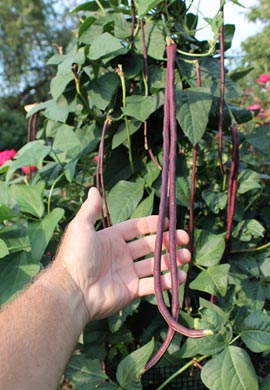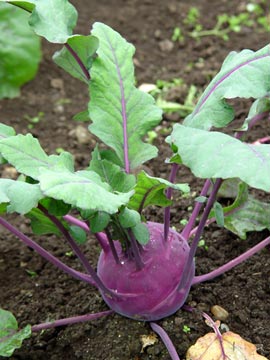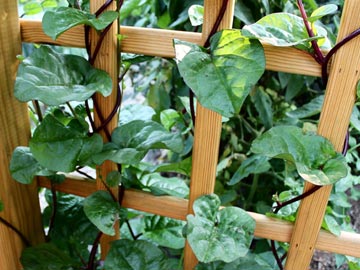Even today’s grocery mega-stores don’t have the space to carry every vegetable worth eating. One of the advantages of growing your own vegetable garden is that you get to experiment with some of the less-traveled choices. If you’re curious about whether blue potatoes taste different from traditional white ones or whether an African horned jelly melon might bef something you’ll like, your own veggie garden can become a trial ground. Many of these uncommon edibles aren’t any more difficult to grow than a basic tomato or cucumber. They’re just not that well known – mainly because people tend to know only what they've seen on the supermarket shelves.
 The pods of Chinese red noodle beans usually grow 18 inches long.
The pods of Chinese red noodle beans usually grow 18 inches long.
© George Weigel
Garden centers carry a few off-the-beaten-path choices in small-plant form, but your best option is starting your own plants from seed. Dozens of seed companies offer just about anything you'd want, ranging from new twists on old favorites to heirloom varieties from yesteryear to crops that are popular in other countries. As with any vegetable, check the seed packet for the best time to plant each of your oddball varieties. The packets also alert you to any particular care needs. Most vegetables – oddballs or not – do best in loose, rich, compost-improved soil in full sun. Keep them watered throughout the growing period, and give them one or two applications of plant fertilizer to maximize performance.
Start with a few of the following. All grow well in home gardens throughout most of the United States.
Chinese red noodle bean
You’ll really impress the neighbors with the size of these pencil-thick, reddish-purple beans. The plants grow as twining vines, and the beans keep producing in hanging clusters throughout the summer – most of them 18 inches long. Chinese red noodle beans are as easy to grow as ordinary pole beans. Plant seeds directly in the garden after frost, water, and watch them climb up arbors, trellises or fencing. Also try similar asparagus or "yard-long" beans.
Kohlrabi
 Kohlrabi looks like something from another planet with its tentacled leaves. This one is a purple variety.
Kohlrabi looks like something from another planet with its tentacled leaves. This one is a purple variety.
© George Weigel
A relative of cabbage and broccoli, kohlrabi looks like something from another planet. It grows just above the soil surface as a solid orb nearly the size of a tennis ball with leafy tentacles sticking out all around. It comes in cream, green and purple versions. Plant kohlrabi seeds into the garden in early spring and harvest the tentacled balls about 2 months later. Peel the skin and eat the crunchy flesh raw with dip – or cook it like a turnip.
Jelly melon
This is really more of a cucumber than a melon, growing on a vine as rounded yellow-orange fruits with horned bumps all over them. It’s another crop that looks other-worldly. Also known as the African horned cucumber or kiwano, jelly melon has seedy, lime green pulp inside, which is the edible and cucumber-flavored part. Some say it has more of a banana, kiwi or tropical-fruit flavor. Fruits can be squeezed to make a juice, or the flesh can be scooped out to make a garnish or flavoring for yogurt.
Radicchio
You've probably eaten leaves of this in store-bought salad mixes without knowing what it was. Radicchio looks like a little purple cabbage, but it’s actually a mildly spicy relative of chicory. It grows as a small rounded plant in cool weather, so direct-seed it early in spring or grow over the winter in the South. The flavor gets bfitter in hot weather. Chop the velvety smooth reddish-purple leaves for salads. Even if you don’t like the flavor, radicchio is a colorful, good-looking plant in the garden.
Edamame beans.
Here’s a trendy one (even though it dates to 11th century B.C.) that’s especially popular with vegetarians and vegans. Edamame beans are a type of soybean known for a particularly sweet flavor in addition to being high in protein, calcium and fiber. Direct-seed them once the soil hits 65 degrees, and harvest them when the pods are plump but before the pea-like seeds inside get too starchy. Eat the seeds (not the shells) as you would English peas. They’re especially good roasted.
Okra.
Okra is a Southern staple used in soups and gumbo or breaded and fried. Although it’s very well known in the South, it’s just as doable direct-seeded as a summer crop in the North. The plant has a tropical look to it, and it produces fat, fleshy pods that point upward. The yellow flowers that come before the fruits are also attractive. And the red-leafed and red-podded versions of okra are good-looking enough to make it an ornamental. The taste? It’s a love-or-hate thing because of the slimy texture.
Malabar spinach
 The purple stems and veins of malabar spinach make it an attractive vine if you don’t like the slimy texture of the leaves in your salad.
The purple stems and veins of malabar spinach make it an attractive vine if you don’t like the slimy texture of the leaves in your salad.
© George Weigel
Really not a spinach at all, this crop is a heat-loving, twining vine that has attractive reddish-purple stems and veins. Direct-seed it after frost and snip leaves all summer for salads. Some people steam it, boil it, stir-fry it and even make a tea out of it. As with okra, malabar spinach leaves have a kind of slimy texture to them (“mucilaginous” as some describe it). Try it and see what you think. Also as with okra, this plant makes a nice ornamental vine even if you don’t eat it.
Arugula
This is just one of many lesser-known greens that can be used to spice up your spring salads. Arugula has a peppery flavor and is best direct-seeded in very early spring, then again in late summer to early fall for a later harvest. It grows throughout winter in the South. While you’re at it, also try purple-leafed orach, corn salad (also known as mache), mizuna and/or the cold-hardiest of all greens, miner’s lettuce. Or buy a "mesclun" mix to grow yourself an assortment of cut-and-come-again greens.